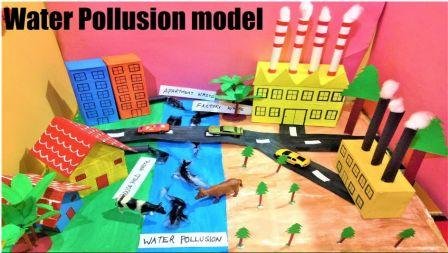Introduction:
Water pollution is defined as the contamination of the sources of water due to various pollutants, human activities.
Water pollution is

The sources of water that get
Various toxic and harmful substances from the farms, cities
In this video, we show how to make water pollution model step by step for science project exhibition in your school. The materials used are easily available at home and can be done with help of your parents too.
Materials Used:
- Glue gun
- Liquid glue
- Chart sheet
- Cardboard
- Paints & brushes
- Thick sheets – 2 – A4 size
- Colored papers – A4 size (Red)
- Empty Cardboard box
- White papers – A4 size
- Cotton
- Rectangular empty cardboard boxes (Like toothpaste box)
- Toy cars, animals for display
You use the resource/tools page section to find the tips where you can buy these materials used at a reasonable cost.
Detailed Video Show How To Make Water Pollution Model For School project
Questions and Answers
- What are the main causes of water pollution?
A. The main causes of water pollution are
These harmful pollutants dissolve easily in the water, thus making the water not eligible for drinking.
2) What are the effects of water pollution?
A. Water pollution not only affects human health but also affects the environment badly. Contaminated water not only causes illness but also causes death.
In the areas where water contamination is caused due to industrial wastes is very dangerous as the groundwater gets affected and thus affecting the daily drinking water for humans.
3) Give examples of water pollution?
A. Few examples of water pollution types are ground water pollution, surface water pollution and ocean water pollution.
4) Name five sources of water pollution?
A. The five sources of water pollution are industrial waste, fertilizers and pesticides, waste water and sewage, river dumping and agricultural waste.
Conclusion:
Water pollution can be reduced by us as individuals starting at the very small level like not pouring oil into the sink, reducing the usage of plastic
Not Throwing the plastic bags and trash into the lakes/rivers
Minimizing the use of fertilizers and pesticides.

